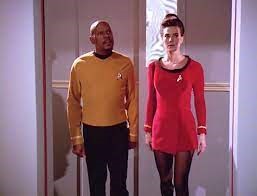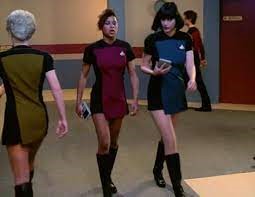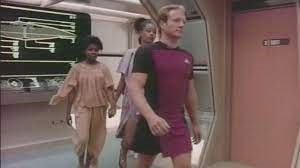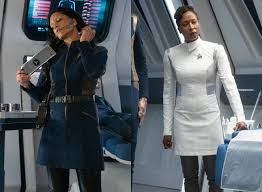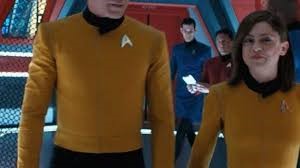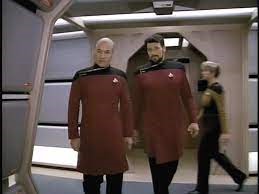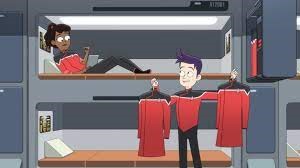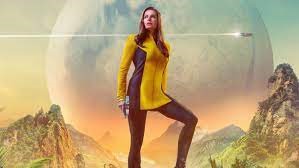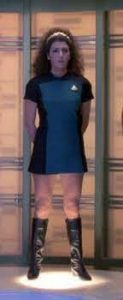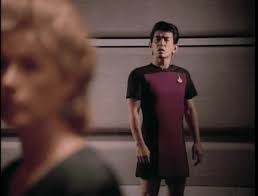Hello and welcome to part one of my four-part Pride-month series: Speculative Fiction and (My) Pride! Across this four-part series, I will be guiding you through an introspective examination of speculative fiction’s impact on how I experience and understand Pride as a member of multiple LGBTQIA+ communities.
Today’s entry, “Imagining Diverse Futures,” is directly inspired by the godfather of visual speculative fiction: Star Trek. Using Star Trek as a case study for speculative fiction, I will highlight examples of profound, accurate and positive representation from across the LGBTQIA+ spectrum found within speculative fiction as a whole, as well as discussing the contexts at play that influenced those moments of major importance.
Speculative Fiction: A broad category of fiction encompassing any story that contains imaginative, futuristic, or supernatural elements.
By its very nature, Spec-fic intersects and overlaps nearly every genre of media, both in the written word and in visual mediums like movies or television. In February 2022, I wrote about spec-fic and its inception and how the subgenre owes its creation in large part to the creative entries of Black authors like Octavia Butler, you can find that post here.
But, spec-fic is also where I find a home for the queer. However, because the role of spec-fi is often, as you may have guessed, to speculate about or imagine possible futures, I have found a wealth of characters and authors who represent the LGBTQIA+ spectrum and do so in a way that holds the potential for vast societal impact. Speculative fiction is preoccupied with asking questions about society, examining how traditions and structural systems operate, and asking why, how and what happens if the system fails. I can think of no better place to begin this discussion than with one of the powerhouses of spec-fic, Star Trek.
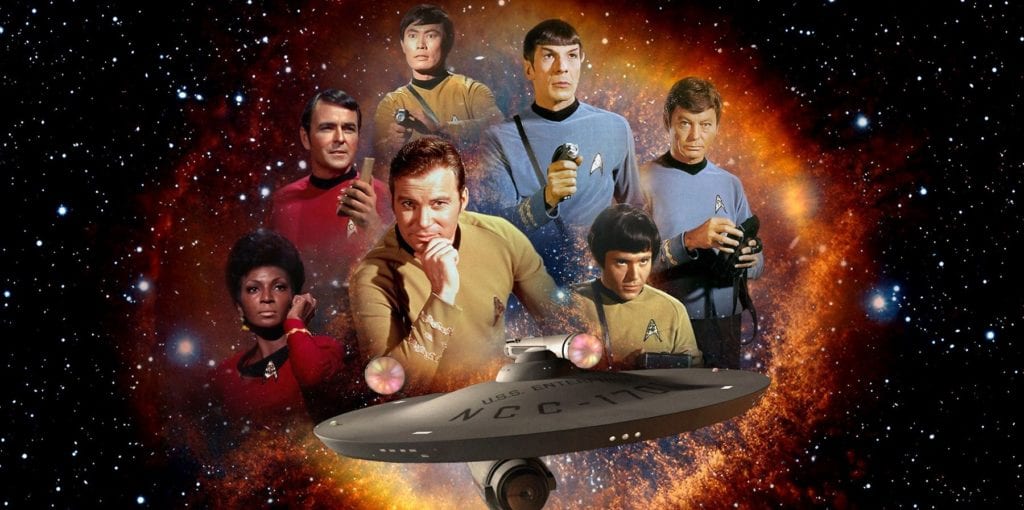
Space: the final frontier. These are the voyages of the starship Enterprise. Its five-year mission: to explore strange new worlds; to seek out new life and new civilizations; to boldly go where no man has gone before!
Star Trek: The Original Series (TOS) aired on television from 1966–1969 in 79 episodes over three seasons, and while it can be challenging to watch for modern audiences brand-new to the franchise, there are some fantastic episodes and moments from the series; not to mention the additional six feature films ranging across 20 years from 1971–1991.
The world of Star Trek is our world in the future, but it offers a more optimistic future wherein humanity has moved beyond its myriad problems and turned to a future of scientific exploration. Or, as creator Gene Roddenberry explained his intentions in creating Star Trek:
Star Trek was an attempt to say humanity will reach maturity and wisdom on the day that it begins not just to tolerate but take a special delight in differences in ideas and differences in lifeforms.
-Gene Roddenberry
While Roddenberry and his creation weren’t perfect examples of inclusivity and diversity in writing, producing, filming and casting, his influence is undeniable. However, even for a franchise largely considered to be progressive in every iteration, attempts at diversity are not always successful. It’s complicated to examine episodes of the franchise from the early days in large part due to the contextual circumstances which have shifted in our culture in subsequent decades. I think many of the attempts the Trek franchise made over the years served as an important piece of roadbuilding; without the clumsy attempts at queer storytelling in the early days, we wouldn’t have gotten to Star Trek: Discovery (Disco) in all its glory. We’ll talk about Disco in part three of this series, but let’s start at the beginning of Trek’s attempt to boldly go where no one has gone before.
Infinite Diversity in Infinite Combinations

Long-time fans of the Star Trek franchise may recognize the acronym IDIC, which stands for the Vulcan maxim Infinite Diversity in Infinite Combinations. Vulcans, an alien race with a deep affinity for logic, practice this concept as a core value for their people, and you’ll see characters ranging from Spock in TOS to T’Pol in Enterprise wearing the symbol which represents IDIC, and looks like this:

Now, the intent of IDIC as a core tenant throughout Trek was not necessarily about the inclusion of specifically LGBTQIA+ identities in the franchise. However, IDIC is certainly about diversity, about the emphasis on not only accepting, but joyfully embracing human diversity, as stated in Roddenberry’s quote above, and it’s been a fairly simple mental exercise for myself and those like me to see IDIC as embracing our identities, too.
TOS explores this core tenet by asking essential questions about humanity throughout the original run of the series. Episodes in the show’s third and final season are set up in terms of narrative melodrama. Episode titles now have referential names, like “Requiem for Methuselah,” which includes a human character encountered by the crew of the Enterprise who has supposedly been alive since Earth’s Mesopotamian era (500+ years BCE). The name Methuselah appears frequently in literature, film and television as a kind of archetypical character which represents longevity or immortality, likely inspired by the Biblical personage of the same name credited with the longest human life span of 969 years.
When television offers this kind of referential attention to detail, I tend to perk up. Usually, this indicates to me a level of layering present in the narrative, i.e., the inclusion of subtext. Think of subtext as the underlying theme or meaning to a text; what is being said, without being said? For a franchise like Star Trek, the subtext of this nature has had a profound impact on subsequent series because the possibilities are now infinite—interpretation of narrative themes is at times individualized, at times communal, but always up for debate. This narrative space also opens the possibility to read yourself into the narrative. What I mean by this is, when you see characters on screen, you can see yourself in them. When there is interpretive space available, it becomes easier for a wide range of people to “read themselves” into the narrative, visualizing a world where people like them can be Starfleet Captains, scientists, communication specialists, engineers or any other possible job you could imagine.
This narrative space remains profoundly important in 2023, but in the late ’60s and into the ’70s, the silent spaces were paramount for the safety of identities who could not otherwise visibly safely exist, like the LGBTQIA+ community as a whole. Contextually, the era was rife with other strife ranging from the Civil Rights movement to the burgeoning female empowerment movement, adding depth and nuance to the identity conversation. For transgender and gender nonconforming cisgender people, the dangers associated with identity were real, and they were profound. For example, colloquially referred to as “three articles” rules or “walking while trans” laws, state and federal statutes in place were often enforced disproportionally intensely for visibly LGBTQIA+ people. Those deemed to be “masquerading” in the perceived opposite gender from their assigned gender at birth could be halted, harassed or arrested. For example, a person perceived to be masculine could be stopped for wearing a dress, or a feminine person wearing a tailored suit. history.com/news/stonewall-riots-lgbtq-drag-three-article-rule
Costumes in Star Trek often reflected a progressive attitude towards clothing. On TOS, Lt. Uhura, played by the late Nichelle Nichols, wears a uniform different than her male crewmates: a red long-sleeved shirt-dress with a micro-mini skirt:
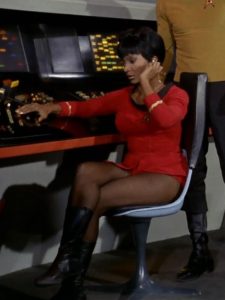
The costume design reflects the stylistic choices of the era, both the MOD aesthetic prevalent in the late ’60’s as well as the birth of the feminist movement. But 20 years later, cultural ideals had shifted, and the miniskirt’s exclusive association with female characters had become uncomfortable and problematic. Rather than removing skirts and dresses from Starfleet uniforms entirely, however, Roddenberry pushed for a truly gender-neutral change for 1987’s premiere of Star Trek’s next installment: The Next Generation (TNG). Bringing back the same designer responsible for Lt. Uhura’s iconic miniskirt, William Ware Theiss, to create the skant, a truly gender-neutral garment, was born. startrek.com/article/celebrating-the-skant
I cannot stress enough how important Roddenberry’s push for a gender-neutral uniform piece inspired by traditionally feminine clothing was. There is an assumption that gender-neutral = vaguely masculine, in that it is always socially acceptable for a woman to wear pants, but never for a man to wear a dress. Recall the context of TOS, where transgender and gender nonconforming people were often harassed or assaulted for wearing clothing that was seen to transcend their assigned gender. In early episodes of TNG, there are invariably crew members of multiple genders seen wearing skants in the background, and the dress uniforms worn by Captain Picard and Commander Riker are derived from the casual skant uniform piece.
This is a great example of visual inclusivity and diversity. In-universe Starfleet crewmembers have the choice of uniform pieces to wear; it follows logically that people would have varied choices as each individual has their own tastes and preferences. In fleshing out background characters in a varied manner, TNG continues Trek’s world of inclusivity and representation. Further, in the franchise’s fourth series, Voyager (VOY) also plays with clothing to queer-code the character of Captain Janeway, the franchise’s first female Captain. The costume seen below is heavily inspired by early queer icons, and the costume design, as well as the acting choices made by Mulgrew in this sequence, firmly affiliate her character with a lesbian history.
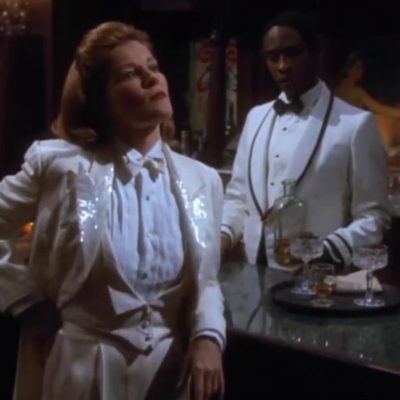
It is clear to me that Gene Roddenberry’s intention to create an inclusive and diverse world has been present since Star Trek’s inception, and small moments in costume design are one of the ways in which I can find commonality between my life and the lives of my LGBTQIA+ predecessors in Trek fandom. But never fear; I have in no way exhausted all the ways in which Star Trek is important and foundational to the way I experience Pride. Please, join me next week when I discuss two very important Star Trek episodes from The Next Generation and Deep Space Nine. Both episodes are fundamentally love stories, romance narratives set against the backdrop of cultural taboos, which is nothing new to Star Trek (romance dominates the plot in numerous episodes from every single series).
You can check out TOS and all six films from the 2nd floor of the library. For an examination of my favorite/most queer episodes in this era, I recommend:
- Season 1 Episode 4, “The Naked Time”
- Season 1 Episode 28, “The City on the Edge of Forever”
- Season 2 Episode 1, “Amok Time”
- Season 3 Episode 9, “The Tholian Web”
- Season 3 Episode 24, “Turnabout Intruder”
- Star Trek II: The Wrath of Khan
As a final thought, I’d like to leave you with a gallery of the best Star Trek uniform piece of all time, the skant. Images below have been lifted from nearly every Trek series, including The Next Generation; Lower Decks; Discovery; and even the 2009 J.J. Abrams alternate-universe film Star Trek. While I wish to see more masculine-appearing people in skants in the future, maybe the prevalence of the uniform piece in newer shows, SNW and Lower Decks, is a sign of future inclusion.
- Deep Space Nine
- The Next Generation
- The Next Generation
- Discovery
- Strange New Worlds
- The Next Generation
- Lower Decks
- Strange New Worlds
- The Next Generation
- Star Trek (2009)

